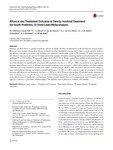Mostrar o rexistro simple do ítem
Alliance and Treatment Outcome in Family-Involved Treatment for Youth Problems: A Three-Level Meta-analysis
| dc.contributor.author | Welmers-van de Poll, M. J. | |
| dc.contributor.author | Roest, J. J. | |
| dc.contributor.author | Van der Stouwe, T. | |
| dc.contributor.author | Van den Akker, A. L. | |
| dc.contributor.author | Stams, G. J. J. M. | |
| dc.contributor.author | Escudero Carranza, Valentín | |
| dc.contributor.author | Overbeek, G. J. | |
| dc.contributor.author | Swart, J. J. W. | |
| dc.date.accessioned | 2024-08-08T10:39:10Z | |
| dc.date.available | 2024-08-08T10:39:10Z | |
| dc.date.issued | 2018-06 | |
| dc.identifier.citation | Welmers-van de Poll, M.J., Roest, J.J., van der Stouwe, T. et al. Alliance and Treatment Outcome in Family-Involved Treatment for Youth Problems: A Three-Level Meta-analysis. Clin Child Fam Psychol Rev 21, 146–170 (2018). https://doi.org/10.1007/s10567-017-0249-y | es_ES |
| dc.identifier.uri | http://hdl.handle.net/2183/38485 | |
| dc.description.abstract | [Abstract] Alliance has been shown to predict treatment outcome in family-involved treatment for youth problems in several studies. However, meta-analytic research on alliance in family-involved treatment is scarce, and to date, no meta-analytic study on the alliance-outcome association in this field has paid attention to moderating variables. We included 28 studies reporting on the alliance-outcome association in 21 independent study samples of families receiving family-involved treatment for youth problems (N = 2126 families, M age youth ranging from 10.6 to 16.1). We performed three multilevel meta-analyses of the associations between three types of alliance processes and treatment outcome, and of several moderator variables. The quality of the alliance was significantly associated with treatment outcome (r = .183, p < .001). Correlations were significantly stronger when alliance scores of different measurement moments were averaged or added, when families were help-seeking rather than receiving mandated care and when studies included younger children. The correlation between alliance improvement and treatment outcome just failed to reached significance (r = .281, p = .067), and no significant correlation was found between split alliances and treatment outcome (r = .106, p = .343). However, the number of included studies reporting on alliance change scores or split alliances was small. Our findings demonstrate that alliance plays a small but significant role in the effectiveness of family-involved treatment. Future research should focus on investigating the more complex systemic aspects of alliance to gain fuller understanding of the dynamic role of alliance in working with families. | es_ES |
| dc.language.iso | eng | es_ES |
| dc.publisher | Springer Link | es_ES |
| dc.relation.uri | https://doi.org/10.1007/s10567-017-0249-y | es_ES |
| dc.rights | Atribución 3.0 España | es_ES |
| dc.rights.uri | http://creativecommons.org/licenses/by/3.0/es/ | * |
| dc.subject | Family-based treatment | es_ES |
| dc.subject | Multilevel meta-analysis | es_ES |
| dc.subject | Therapeutic alliance | es_ES |
| dc.subject | Treatment outcomes | es_ES |
| dc.subject | Working alliance | es_ES |
| dc.title | Alliance and Treatment Outcome in Family-Involved Treatment for Youth Problems: A Three-Level Meta-analysis | es_ES |
| dc.type | info:eu-repo/semantics/article | es_ES |
| dc.rights.access | info:eu-repo/semantics/openAccess | es_ES |
| UDC.journalTitle | Clinical Child and Family Psychology Review | es_ES |
| UDC.volume | 21 | es_ES |
| UDC.startPage | 146 | es_ES |
| UDC.endPage | 170 | es_ES |






